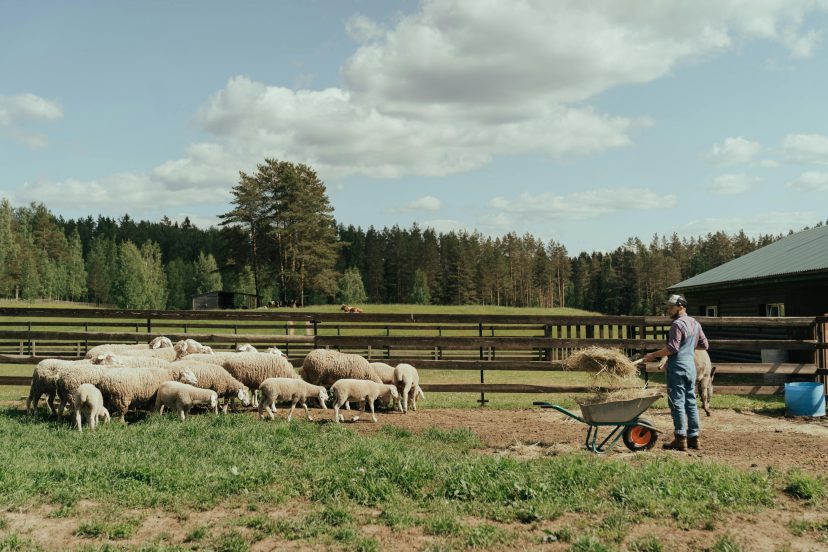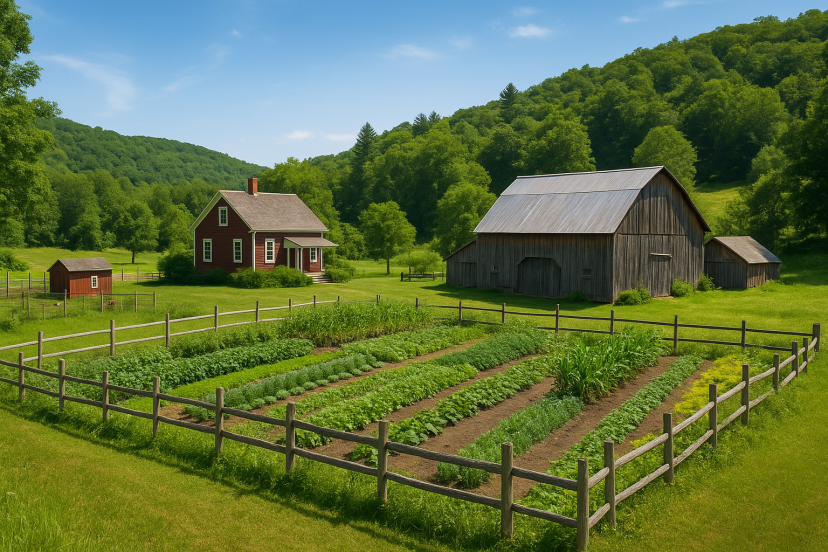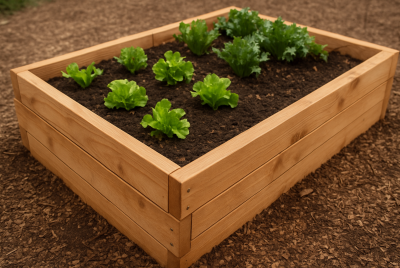How to Start a Homestead from Scratch (Step-by-Step Guide)
We may earn a commission for purchases made using our links. Please see our disclosure to learn more.
Starting a homestead from scratch can feel exciting and intimidating at the same time. You might dream of growing your own food, raising animals, and living more simply — but wonder where to begin. The truth is, you don’t need to be an expert farmer or own hundreds of acres. You just need a clear plan, patience, and a desire to live a little closer to the earth. If you’ve been wondering how to start a homestead, this step-by-step guide will walk you through everything you need to start this rewarding lifestyle.
Why Homesteading Is Good for You — and Why It Works
Homesteading isn’t just a peaceful lifestyle — it’s something science actually supports. Studies show that living closer to the land can improve your health, strengthen communities, and even help the planet.
1. The Simple Life Is Good for You (and the Earth)
According to Vermont Land & Farm, people who homestead often feel more grounded and less stressed. Working with your hands, spending time outside, and growing your own food connect you to nature in ways modern life doesn’t.
But it’s not just about the emotional side. Their article explains that homesteading helps build healthier soil, reduce waste, and cut down on harmful chemicals in food production. When you compost, rotate crops, or raise animals responsibly, you’re creating a small ecosystem that supports both your family and the environment.
Think of it as a full-circle lifestyle — one where what you give to the earth comes right back to you in the form of healthy food, clean air, and a calmer mind.
2. Renewable Energy Makes It Even Better
A 2023 study published in the Sustainability journal by Bathaei and colleagues looked at how renewable energy fits into farming and homesteads. The researchers found that solar power, wind energy, and bioenergy can cut carbon emissions by up to 80% while saving money over time.
For homesteaders, that’s a game-changer. Imagine running your water pumps, greenhouse lights, and electric fences without worrying about power bills. Solar energy makes that possible.
It’s also practical — during power outages or bad weather, renewable systems keep your homestead running smoothly. That means more peace of mind and less dependence on outside systems.

Why It Matters
Put simply, these studies confirm what many homesteaders already know: living close to the land is good for people, communities, and the planet. The Vermont Land & Farm article shows the emotional and ecological benefits, while the MDPI research explains how technology can make sustainable living even more achievable.
Together, they paint a hopeful picture — one where simple living and modern innovation work hand in hand.
So when you plant your garden, hang your laundry in the sun, or install a solar panel, remember — you’re not just saving money. You’re building a better future, one small step at a time.
Step 1: Set Clear Goals
Before you grab a shovel or buy animals, take time to think about what kind of homestead fits your life.
Do you want to grow vegetables, raise chickens, or make your own cheese? Are you aiming for full self-sufficiency or just a simpler, healthier routine?
When figuring out how to start a homestead, it helps to begin small. Maybe it’s a few raised garden beds or a handful of hens for fresh eggs. Those first steps will teach you a lot about time, effort, and what you truly enjoy.
👉 Pro Tip: Check out this guide on fall cover crops to learn how seasonal planting can naturally improve your soil and reduce fertilizer use. It’s a smart way to prep your garden for long-term success.
Step 2: Find the Right Land
Your land doesn’t need to be huge — it just needs to work for your goals. Look for these key things:
- Good soil: Healthy soil saves you from years of frustration.
- Water access: A well, pond, or nearby stream makes a big difference.
- Sunlight: You’ll need open areas for growing food and solar energy.
- Zoning laws: Check that your property is zoned for small-scale farming or raising animals.
Even one or two acres can be enough for a thriving homestead if managed wisely.
If you already have a yard, start there. A few containers or a small garden bed can teach you plenty before committing to larger land.
Learning how to start a homestead often begins right where you are — you don’t need a big move or a huge budget to get started.
Step 3: Build Your Infrastructure
Homesteading means creating systems that work for you — not against you. Think about the basics:
- Shelter: Start with something simple and practical.
- Water: Use rain barrels or a filtration system for a sustainable supply.
- Energy: You can use solar panels or small wind turbines to generate your own power.
- Storage: A small shed, barn, or root cellar keeps tools and food safe.
You don’t need to do it all at once. Many homesteaders build over time, improving as they go. Focus on consistent progress instead of trying to make everything flawless.
Step 4: Start Your Garden
Your garden will likely be the heart of your homestead. Begin with easy crops like tomatoes, lettuce, beans, or herbs. They’re forgiving and give quick rewards.
If you’re new to gardening, remember: healthy soil is everything. Compost your food scraps, use mulch to keep moisture in, and rotate crops every season. Over time, your soil becomes richer — meaning better harvests each year.
If it’s too late in the season to plant, you can grow cover crops to feed your soil naturally through the colder months.

Step 5: Add Livestock Slowly
Animals bring your homestead to life, but they also add daily responsibility. Start small. Chickens are a great first choice — they give you eggs, eat pests, and require little space.
Later, you might add goats for milk, rabbits for compost material, or ducks for pest control. The key is balance. Every new animal means more feeding, cleaning, and care.
If you take on too much too soon, it can feel overwhelming. Grow your setup as your confidence grows. That’s a big part of how to start a homestead the right way — one step at a time.
Step 6: Learn Core Skills
Homesteading is really about learning by doing. Some days you’ll feel like an engineer, other days a gardener or cook.
Here are some must-learn skills:
- Growing and preserving food
- Composting and soil care
- Basic carpentry and plumbing
- Animal care and first aid
- Using renewable energy safely
You can learn a lot for free from YouTube tutorials, local workshops, or community colleges. The more you know, the less you’ll depend on outside systems — and the more rewarding this lifestyle becomes.
Step 7: Keep Track of Costs
Starting a homestead doesn’t have to drain your wallet, but it does take planning. Keep a simple notebook or spreadsheet for expenses — seeds, tools, fencing, feed.
Whenever you sell extra eggs, vegetables, or homemade products, note the income too. This helps you see where your money goes and how your homestead grows.
Many people who research how to start a homestead find that repurposing materials or trading skills helps them save a lot of money in the first year.
Step 8: Join a Community
Homesteading can sometimes feel lonely, especially when you’re learning everything yourself. But you’re not alone. There are local and online communities full of people on the same journey.
Find a local co-op, farmer’s market, or online group. Ask questions, share experiences, and celebrate small wins. You’ll be amazed how generous homesteaders are with advice and encouragement.
Step 9: Be Patient and Consistent
The first year is the hardest. You’ll make mistakes — maybe your crops fail or an animal gets sick. Don’t give up. Every challenge teaches you something.
Homesteading rewards patience. With time, you’ll develop rhythms and routines that make life smoother. You’ll learn to trust the process and enjoy the small things — like your first batch of homegrown vegetables or a morning spent watching your animals roam.
That’s the real secret of how to start a homestead that lasts — patience, passion, and a willingness to learn along the way.
Essential Tools for New Homesteaders
Here are a few tools that make life easier when you’re starting out:
- Fiskars 3-Claw Weeder – Keeps your garden tidy without chemicals.
- VIVOSUN Seed Starter Kit – Great for growing plants indoors.
- Solar Generator Kit – Reliable backup power for off-grid living.
- Fermentation Crock – Perfect for pickling and fermenting food.
- Automatic Chicken Coop Door – Makes caring for your flock simpler.
These aren’t just gadgets — they’re small helpers that save you time and make daily work smoother.
Conclusion
Starting a homestead from scratch isn’t about having everything figured out. It’s about learning, adapting, and growing — both in the garden and in life. Every seed you plant, every tool you use, and every skill you learn moves you closer to real freedom. The best part is, you don’t have to get it all right from the start. When you understand how to start a homestead, it stops feeling like an impossible dream and starts becoming a daily reality — one filled with good food, hard work, and genuine joy. Homesteading is a journey toward a simpler, stronger, and more sustainable way of living.
FAQs
1. How do you create a homestead?
Start small. Focus on growing your own food, setting up water and energy systems, and learning as you go.
2. How do you make money in homesteading?
Sell extra eggs, vegetables, handmade soaps, or crafts. Some people also teach workshops or share their journey online.
3. What’s the easiest farm to start for beginners?
A vegetable garden with a few chickens. It’s affordable, low-maintenance, and rewarding.
4. What are common homesteading mistakes?
Starting too big, skipping soil prep, or underestimating animal care. Go slow and steady — that’s how you win in homesteading.
5. How much land is ideal for a homestead?
It’s absolutely possible to begin homesteading on less than an acre of land. For full self-sufficiency, 5–10 acres is usually enough.




